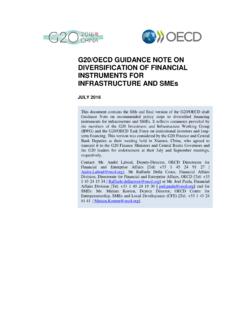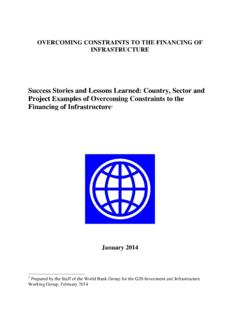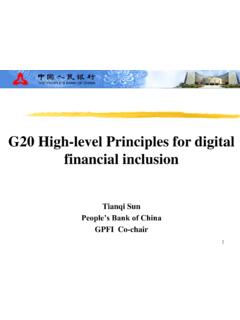Transcription of G20/OECD SUPPORTING NOTE TO THE GUIDANCE NOTE ON ...
1 1 This document contains the third and final version of the SUPPORTING note on diversified financing instruments for SMEs. It has been revised based on several rounds of comments provided by the G20/OECD Task Force on Institutional Investors and Long-term financing and the G20 IIWG meetings. This note was considered by the G20 Finance and Central Bank Deputies at their meeting held in Xiamen, China, who agreed to transmit it to the G20 Finance Ministers and Central Banks Governors and the G20 leaders at their July and September meetings, respectively. Contact: Mr. Andr Laboul, Deputy-Director, OECD Directorate for Financial and Enterprise Affairs [Tel: +33 1 45 24 91 27 | Ms. Miriam Koreen Deputy Director [Tel: +33 1 45 24 81 41 | JULY 2016 G20/OECD SUPPORTING NOTE TO THE GUIDANCE NOTE ON DIVERSIFIED FINANCIAL INSTRUMENTS, SMEs 2 This report is circulated under the responsibility of the Secretary-General of the OECD.]]
2 The opinions expressed and arguments employed herein do not necessarily reflect the official views of OECD member countries or of the G20. This document and any map included herein are without prejudice to the status of or sovereignty over any territory, to the delimitation of international frontiers and boundaries and to the name of any territory, city or area. OECD 2016. Applications for permission to reproduce or translate all or part of this material should be made to: 3 TABLE OF CONTENTS EXECUTIVE SUMMARY .. 4 1. Framework and preconditions .. 5 2. Diversifying financing instruments for SMEs .. 7 Strengthening SME access to traditional bank financing .. 7 Broadening the range of financing instruments available to SMEs .. 7 Asset-based finance .. 8 Alternative debt instruments .. 9 Crowdfunding .. 10 Hybrid instruments .. 10 Equity finance .. 10 3. Conclusions and GUIDANCE .. 13 REFERENCES .. 19 Tables Table 1. Alternative external financing techniques for SMEs and entrepreneurs.
3 7 Table 2. Suitability of alternative financing instruments for different firm profiles and stages .. 8 Table 3. Private equity by stage .. 12 Table 4. G20/OECD high -level principles on SME financing .. 14 Figures Figure 1. A valuable ecosystem for SME equity offerings .. 6 4 G20/OECD DRAFT PROGRESS REPORT ON DIVERSIFICATION OF FINANCIAL INSTRUMENTS AND RELATED GUIDANCE DIVERSIFYING financing INSTRUMENTS FOR SMEs EXECUTIVE SUMMARY Bank lending is the most common source of external finance for many SMEs and entrepreneurs, which are often heavily reliant on straight debt to fulfil their start-up, cash flow and investment needs. While commonly used by small businesses, traditional bank finance poses challenges to some categories of SMEs and may not be the most appropriate form of finance at specific stages in the firm life cycle. In particular, debt financing appears to be ill-suited for newer, innovative and fast growing companies with a higher risk-return profile and few pledgeable assets, which typically face a growth capital gap.
4 Capital gaps exist also for companies seeking to internationalise and to effect important transitions in their activities, such as ownership and control changes, structures, or to de-leverage and improve their capital structures, or for larger SMEs growing into intermediate-sized enterprises. In the aftermath of the 2008-09 global financial crises, as banks have been contracting their balance sheets in order to meet more rigorous prudential rules, the credit constraints experienced by SMEs in many countries further highlighted the vulnerability of the SME sector to changing conditions in bank lending and regulations. Recognising the complementary nature of the role of banks and other financing channels, the G20/OECD high -level principles on SME financing call for strengthening SME access to traditional bank financing and improving their access to a broad range of financing instruments, to enable them to obtain the form and volume of financing best suited to specific needs and stage of the firm life-cycle.
5 Multiple and competing sources of finance for SMEs should be supported, including asset-based finance, alternative forms of debt, hybrid tools and equity instruments. Capital market financing can offer the possibility to tap into a broad range of funding sources, including institutional investors, to support SME innovation and growth, provided an appropriate measure and management of associated risks are conducted. At the same time, capital markets, which typically seek opportunities for higher returns than in traditional debt markets, are not an appropriate source of finance for all SMEs. Equity finance holds particular promise for companies that have a high risk-return profile, such as new, innovative and high growth firms. Seed and early stage equity finance can boost firm creation and development, while other equity instruments, such as specialized platforms for SME public listing, can provide financial resources for growth-oriented SMEs. A number of challenges persist that limit banks capacity to lend to small businesses and SMEs uptake of non-bank-finance instruments, most of which are currently at the reach of only a small share of SMEs.
6 On the demand side, many entrepreneurs and business owners lack financial knowledge, strategic vision, resources and sometimes even the willingness or awareness to successfully attract finance other than straight debt. The lack of appetite by SMEs for alternative financial instruments, equity in particular, can also in parts be attributed to their tax treatment vis- -vis straight debt. On the supply side, potential investors face an overall opacity of the SME finance market, which is characterised by large information asymmetries and a scarcity of transparent credit data, a lack of exit options, as well as regulatory impediments. As a consequence of these obstacles, financial instruments for SMEs often operate in thin, illiquid markets, with a low number of market participants, which, in turn drives down demand from SMEs and discourages potential suppliers of finance. 5 The development of diversified financing instruments and markets for SMEs requires appropriate framework conditions, in terms of regulation, taxation, transparency and connectivity.
7 In particular, SME equity markets rely on specialised ecosystems which foster links between growth-oriented companies and a variety of specialised financial institutions and service providers. Governments, international organisations, multilateral development banks (MDBs) and other stakeholders have a variety of policy options at their disposal to address these challenges, including regulatory tools, the enhancement of credit risk information infrastructures, financial literacy schemes, investor-readiness programmes, initiatives to improve SME linkages with the investor community and policies to leverage private resources, among others. A holistic approach is needed to address demand- and supply-side obstacles in tandem, taking into account diverse circumstances and different economic, social and regulatory environments. The development of Effective Approaches for the implementation of the voluntary G20/OECD high -Level principles on SME financing will support governments in identifying and designing appropriate policy measures in ways suited to their national contexts and challenges of their SME population.
8 1. Framework and preconditions The development of healthy and responsive financial markets relies on suitable framework conditions, set out in the Progress Report on the Diversification for financing Instruments for Infrastructure. For the diversification of SME financing instruments, there may be additional specific considerations in terms of regulation, taxation, transparency and connectivity. The growth orientation of SMEs as well as their capacity to approach non-bank financing channels should also be taken into account. financing instruments alternative to straight debt typically alter the traditional risk-sharing mechanism of debt contracts, implying higher risks for the financiers, in the expectation of higher returns. Against this backdrop, a sound regulatory environment, which ensures investor protection and financial stability, while SUPPORTING a range of financing instruments for SMEs, represents a key enabling factor for the diversification of SME financing sources.
9 Regulatory certainty is especially important to ensure a predictable and stable operating environment for firms and investors. Efficient insolvency procedures and strong right enforcement mechanisms can increase the confidence of a broad range of investors in SME markets. Transparency in SME finance markets is needed to attract investors and help them identify investment opportunities, particularly in the riskier segment of the market, including equity finance. By providing an accurate reflection of the risk involved in SME finance, disclosure requirements and practices and information infrastructures for credit risk assessment can reduce the financing costs for SMEs, which are typically larger than for large firms. Interconnectedness of financial markets, across investment segments and constituencies, is another important factor for the development of financing opportunities for growth-oriented SMEs. Connectivity enhances information flows and transparency, increases liquidity in SME finance markets, contributes to opening profitable exit options for investors and provides opportunities for follow-on finance for early stage ventures.
10 Connectivity of diverse financing sources with the banking system is also crucial for the long-term development of alternative instruments. Indeed, most alternative financing tools should be regarded as complementary, rather than competitive, to bank financing . A well-functioning banking system represents a pre-condition for the development of most alternative financing tools, including innovative instruments, such as crowdfunding, which requires a well-established infrastructure for payments, as well as information about the creditworthiness of entrepreneurs. 6 Across alternative financing markets, suitable framework conditions need to be matched by adequate financial skills on the demand side. Broad awareness about financing sources for diverse business needs and financial skills developments are preconditions for SMEs financing diversification strategies and the uptake of most financial instruments other than straight debt. The quality of investment and entrepreneurial projects are especially important for attracting equity investors.





